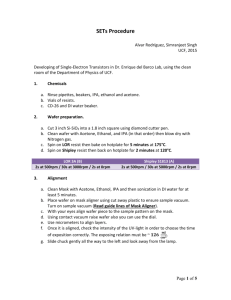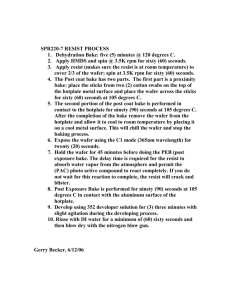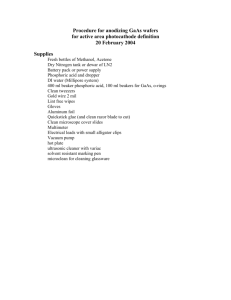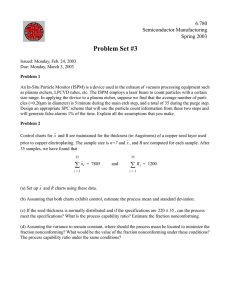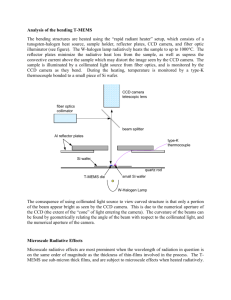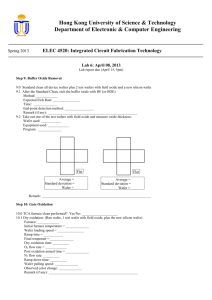SET Procedure
advertisement
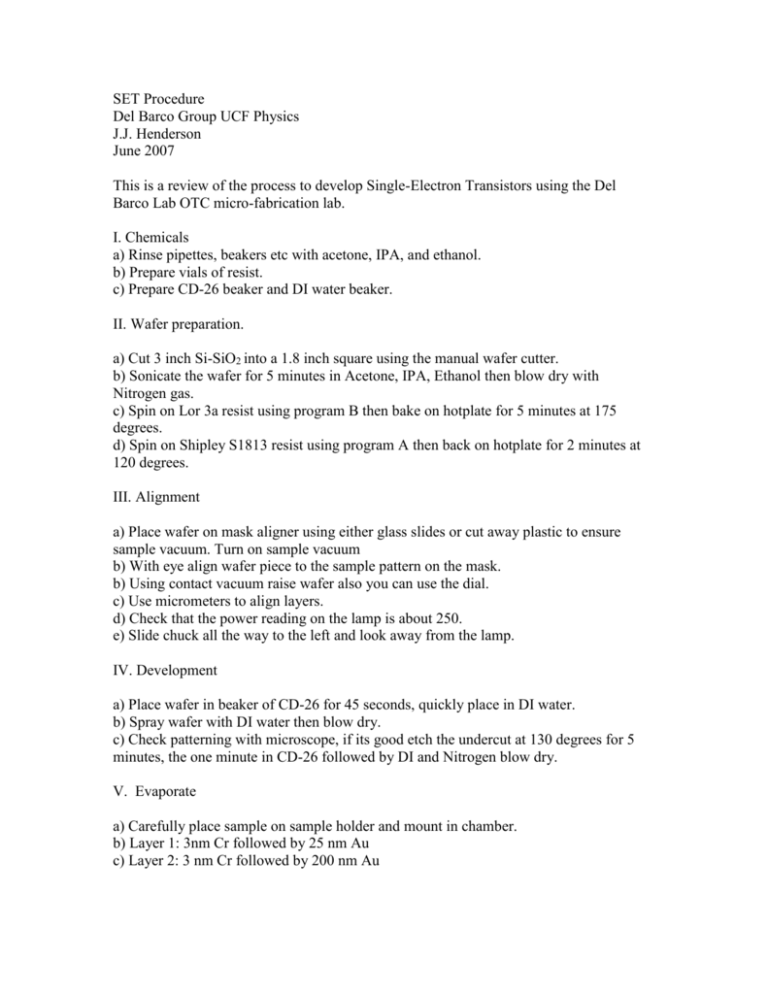
SET Procedure Del Barco Group UCF Physics J.J. Henderson June 2007 This is a review of the process to develop Single-Electron Transistors using the Del Barco Lab OTC micro-fabrication lab. I. Chemicals a) Rinse pipettes, beakers etc with acetone, IPA, and ethanol. b) Prepare vials of resist. c) Prepare CD-26 beaker and DI water beaker. II. Wafer preparation. a) Cut 3 inch Si-SiO2 into a 1.8 inch square using the manual wafer cutter. b) Sonicate the wafer for 5 minutes in Acetone, IPA, Ethanol then blow dry with Nitrogen gas. c) Spin on Lor 3a resist using program B then bake on hotplate for 5 minutes at 175 degrees. d) Spin on Shipley S1813 resist using program A then back on hotplate for 2 minutes at 120 degrees. III. Alignment a) Place wafer on mask aligner using either glass slides or cut away plastic to ensure sample vacuum. Turn on sample vacuum b) With eye align wafer piece to the sample pattern on the mask. b) Using contact vacuum raise wafer also you can use the dial. c) Use micrometers to align layers. d) Check that the power reading on the lamp is about 250. e) Slide chuck all the way to the left and look away from the lamp. IV. Development a) Place wafer in beaker of CD-26 for 45 seconds, quickly place in DI water. b) Spray wafer with DI water then blow dry. c) Check patterning with microscope, if its good etch the undercut at 130 degrees for 5 minutes, the one minute in CD-26 followed by DI and Nitrogen blow dry. V. Evaporate a) Carefully place sample on sample holder and mount in chamber. b) Layer 1: 3nm Cr followed by 25 nm Au c) Layer 2: 3 nm Cr followed by 200 nm Au d) Layer 3: 24 nm of Al (cool with nitrogen once at low pressure then wait 6-8 hrs to remove from vacuum). VI. Lift off a) Place sample in Remover PG at 80 degrees then check periodically b) Spray with PG to help the lift-off (not on the Al layer since no Cr) VII. Gates a) Once lifted off check with meter or probe station whether the gates are conducting properly. b) Allow gates to oxidize in atmospheric conditions for 12 hrs VIII. E-beam Lithography a) Spin on MMA resist with program E. b) Bake for 15 minutes at 175 degrees. c) Spin on PMMA resist with program F. d) Bake for 15 minutes at 175 degrees. e) Take it to CREOL IX. Nano-wire Developing a) Develop sample in 3 IPA : 1 MIBK b) Rinse with IPA and blow dry c) Check patterning under microscope if necessary develop a bit more. X. Nano-wire Evaporation a) CAREFULLY mount sample in chamber. b) Evaporate 24 nm of Au. c) Remove from chamber XI. Nano-wire Lift-off a) Place sample in RT Acetone and leave it over night. It helps to prop the sample up again the beaker wall. b) Don’t rush or the wires will be gone. c) Lift sample out of Acetone and see if the gold comes off. d) If it doesn’t right away wait a little bit longer. e) If it still doesn’t come off try spraying gently with Acetone. f) Blow dry with a very light stream of nitrogen gas. XII. Does it work? a) Check that the gates are still conducting b) Check that there are indeed wires there (~70 ohm at RT) by measuring with probe station. c) Check if there is a leak between the sources (drain) and gates with probe station. d) If there is a leak check ALL chips to check, if all of them leak them you just wasted lots of time and money. XIII. Measuring a) Using the closed cycle system check a chip that has lots of wires at low T. b) Break a wire or two using the straight voltage sweep breaking software. Note the voltage it broke at. b) Using the feedback controlled software break wires using a critical voltage noted in the previous step. c) If there is some conduction there immediately check for leaks to the gate. d) Assuming the gate is working try taking some I-V curves with varying gate (-1, +1 volts say). Be mindful of the gate oxide it could crack if you up the voltage too much leaving you with a leak and the entire device being bad.

